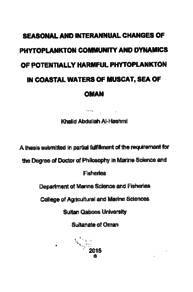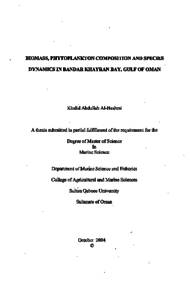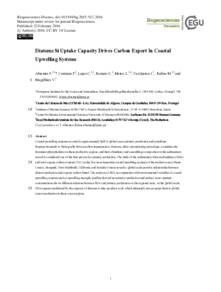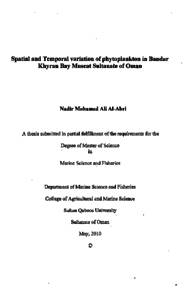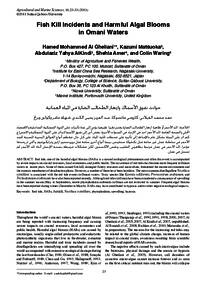وثيقة
Seasonal and interannual changes of phytoplankton community and dynamics of potentially harmful phytoplankton in coastal waters of Muscat, Sea of Oman
الناشر
Sultan Qaboos University
ميلادي
2015
اللغة
الأنجليزية
الموضوع
الملخص الإنجليزي
Comprehensive data are presented on the species composition, seasonal and interannual abundance of diatoms and dinoflagellates, trends in the abundance of potentially harmful microalgae in relation to the physical and chemical parameters that affect abundance and distribution from April 2006 through April 2011 from a single location in the Bay of Bandar Khayran (BK). In addition, the spatial and temporal variability of phytoplankton in Bandar Khayran bay as an enclosed ecosystem was compared to offshore waters (OFF) of Muscat as an open ecosystem. Moreover, the temporal variability in sizefractionation of a natural phytoplankton population was investigated to estimate the relative contribution of the different size classes to the overall phytoplankton community and their relationship to environmental conditions.
A total of 278 dinoflagellate and diatom taxa were recorded during the study. The Dinophyceae contributed the highest number of species (166) followed by Bacillariophyceae (112). The number of genera present was largest during the Southwest Monsoon (SWM) followed by the Northeast Monsoon (NEM) and lowest during the Spring Intermonsoon (SPIM) with considerable interannual variability. Dinoflagellates were the most important group in the Bay of Bandar Khayran. They constituted 59.7 % of the total species identified in the Bay and dominated the total phytoplankton population most of the year. During the study period, they comprised 83% of the total abundance and 88 % of the total biomass. Diatoms were the second important group and contributed 40.3 % to the total species identified in the Bay. They comprised only 17% of the total abundance and only 11 % of the total biomass during the study period. Diatoms were observed in countable numbers only during 2006 and 2010. Higher abundances of diatoms were observed during February March and AugustSeptember (NEM and SWM respectively) when higher input of nutrients were noticed. Chlorophyll a (Chl a) was associated with diatoms and diatoms were dependent on silicate concentrations. Increases in diatom abundance and their association with phosphate, ammonia and silicate were coupled primarily with a decrease in temperature. Also a weak association was found between dinoflagellate species (except Noctiluca scintillans) and nutrients. The dinoflagellate assemblages that dominated the sampling periods and persisted annually were those in the 15-55 um size range: Prorocentrum minimum, Gymnodinium sp., Scrippsiella trochoidea, Gymnodinium simplex and Prorocentrum micans. This implies a minor effect of grazing pressure on these species.
In total, 24 potentially harmful algal species were identified, including 11 species of dinoflagellates and eight species of diatoms. The dinoflagellates Prorocentrum minimum , Scrippsiella trochoidea, and Noctiluca scintillans were most abundant during the Southwest Monsoon (SWM, July-September) and Northeast Monsoon (NEM, January-March) seasons, while other species occurred in low abundance and with no clear seasonal patterns. A dense bloom of Cochlodinium polykrikoides that affected the distribution and abundance of other harmful algal species (HABs) was observed for the first time in the Sea of Oman during 2008-2009. Prorocentrum minimum increased in abundance during
and after the decay of the Cochlodinium bloom while S. trochoidea was suppressed during this bloom, increasing thereafter once again. Noctiluca scintillans disappeared in the late SWM and NEM of 2008 and SWM of 2009, when blooms typically occur annually. Prorocentrum minimum and S. trochoidea persisted throughout the annual cycle of all years, enhancing their capability to bloom in the region under favorable conditions of high light intensities, and relatively warm waters of low turbulence.
Phytoplankton communities at both at BK and OFF stations showed no significant differences in phytoplankton community composition. However, higher chlorophyll a concentrations and phytoplankton abundance were observed inside BK than in the OFF station during SWM and NEM seasons. This was related to the Bay's unique hydrographic conditions and possibly due to the reduced grazing pressure. Phytoplankton communities at both locations were dominated by dinoflagellates. Despite that, diatom abundance was not significantly different between BK and OFF; it was found that certain taxa dominating each station are spatially and temporally different.
Nanoplankton was the most important class contributing 54.4% to total Chla (range 6-82%). Their seasonal highest concentration was during the cold periods when temperature ranged from 28-29 °C in SWM and near 24 °C in the NEM when the supply of nutrients was sufficient to sustain their growth. Picoplankton occupied the second level of the contribution, comprising 23.5%, range 4-74 % of the total Chl a, and their concentration was generally constant (0.04-06 ug L-?) throughout the study periods. A drop in the picoplankton population coincided with increases in the microplankton and nanoplankton populations indicating a high grazing pressure exerted on the picoplankton population. The microplankton size-class occupied the third level of the contribution comprising 22.2%, range 3-65 %. Their general concentration was below 0.1 ug Land only dominant when temperatures were lowest and nitrate, nitrite, silicate and phosphate concentrations were highest.
Although Bandar Khayran is located at the limit of the tropical range, its shows temperate dynamics, seasonal temperature fluctuations, spring and summer phytoplankton blooms and high diversity. The Southwest and Northeast Monsoons provide the proper environmental factors for the bloom occurrences and Phytoplankton abundances.
المجموعة
URL المصدر
الملخص العربي
تم تقديم بيانات شاملة للداياتومات (Diatoms) والسوطيات الدوارة (dinoflagellates) والعناصر الضارة منها عن مدى وفرتها وتوزيعها الموسمي والسنوي وعلاقتها بالمتغيرات البيئية البحرية الفيزيائية والكيميائية الطارئة على مياه خلیج بندر خيران وذلك من أبريل 2006 إلى أبريل عام 2011 . كذلك تمت مقارنة تأثير التغير المكاني والزماني على هذه العوالق النباتية في خليج بندر خيزان كنظام بيئي شبه مغلق مقارنة مع المياه العميقة المفتوحة على ساحل مسقط كنظام بيئي مفتوح. علاوة على ذلك، تم التحقيق من التباين الزمني في حجم تجزئة صبغة الكلوروفيل من العوالق النباتية الطبيعية لتقدير المساهمة النسبية للأنواع المختلفة من هذه العوالق النباتية الكتلة الحيوية وعلاقتها مع الظروف البيئية.
تم التعرف على ما مجموعه 278 طائفة من العوالق النباتية خلال فترة الدراسة. ساهمت السوطيات الدوارة ب166 طائفة تلتها الداياتومات ب 112 طائفة وكان عدد الأجناس أكبر خلال موسم الرياح الموسمية الجنوبية الغربية ومن ثم خلال موسم الرياح الشمالية الشرقية ومحققا أدني مستوى خلال الربيع مع تفاوت كبير خلال السنوات المختلفة . شكلت السوطيات الدوارة أهم مجموعة في خليج بندر خيران حيث ساهمت ب 7 , 59 % من مجموع الأنواع التي تم تحديدها في الخليج وهيمنت على مجموع العوالق النباتية خلال العام حيث شكلت 83٪ من الوفرة الإجمالية و ٪88 من إجمالي الكتلة الحيوية .أما الداياتومات فشكلت المجموعة الثانية المهمة حيث ساهمت بنسبة ٪40 , 3 من إجمالي الأنواع التي تم تحديدها في الخليج وشكلت 17٪ فقط من الوفرة الإجمالية و11% فقط من إجمالي الكتلة الحيوية خلال فترة الدراسة .وقد لوحظت الداياتومات بنسبة أعلى فقط خلال 2006 و 2010 وشكلت أعلى وفرة لها خلال شهر فبراير ومارس وأغسطس وسبتمبر تزامنا مع ارتفاع تركيز المغذيات الطبيعية في الماء عند هبوب الرياح الموسمية الجنوبية الغربية. والرياح الموسمية الشمالية الشرقية. ارتبط ارتفاع تركيز الكلوروفيل مع وجود الداياتومات واعتمدت الداياتومات على تركيز السيليكات إلى جانب وفرة الفوسفات والأمونيا مع انخفاض في درجات الحرارة. في المقابل لم يتم العثور على صلة وثيقة بين السوطيات الدوارة (باستثناء النوكتيلوكا) والمواد المغذية . إن الأنواع التي هيمنت على فترات أخذ العينات. وهي كلها من مجموعة السوطيات الدوارة. كانت تلك في نطاق حجم 15-55 ميكرومتر وهي Prorocentrum Scrippsiella trochoidea y Gymnodinium sp. Gminimum simplex Gymnodinium و Prorocentrum micans . إن هذا يشير إلى التأثير البسيط الذي يمثله استهلاك العوالق الحيوانية لهذه الأنواع من العوالق النباتية هذا و قد تم تحديد 24 نوعا من الطحالب الضارة المحتملة حيث كان احد عشرة نوعا من السوطيات الدوارة وثمانية أنواع من الداياتومات و كانت السوطيات Prorocentrum minimum و Scrippsiella trochoidea و Noctiluca scintillans الأكثر وفرة خلال موسم الرياح الجنوبية الغربية ( يوليو-سبتمبر) والشمالية الشرقية ( يناير- مارس) ، في حين كانت الأنواع الأخرى اقل وفرة وبدون أي نمط موسمي.واضح. لقد كان لمد الأحمر الكثيف للطحلب الضارCochlodinium polykrikoides الذي شوهد لأول مرة في بحر عمان خلال الفترة 2008-2009- تأثير كبير على وفرة وتوزيع الأنواع الأخرى من الطحالب الضارة. لقد تم ملاحظة زيادة في وفرة الطحلب Prorocentrum minimum أثناء وبعد اضمحلال از هرار Cochlodinium polykrikoides في حين قل بشكل ملحوظ وفرة Scrippsiella trochoidea خلال هذا الأزهرار، وزيادة في الوفرة بعد ذلك مرة أخرى. أما أكبر تأثير لهذا المد الأحمر فهو اختفاء النوكتيلوكا Noctiluca scintillans لأول مرة في بحر عمان خلال موسم الرياح الجنوبية الغربية ( يوليو-سبتمبر) والشمالية الشرقية ( يناير- مارس) من 2008 وخلال موسم الرياح الجنوبية الغربية من 2009. في الجانب المقابل حافظت كل من Prorocentrum minimum و Scrippsiella trochoidea على تواجدهما ووفرتهما طيلة شهور العام لجميع سنوات البحث، وبهذا فقد عززا قدرتهما على الأزهرار في المنطقة في ظل ظروف مواتية من شدة الضوء العالية، والمياه الدافئة نسبيا مع انخفاض نسبي لاضطراب مياه البحر. لم توجد فروق كبيرة في تكوين مجتمع العوالق النباتية المائية في كل من محطات البحث BK و OFF غير انه لوحظ ارتفاع في تركيز الكلوروفيل وفي وفرة العوالق النباتية داخل BK مما كانت عليه في محطة OFF خلال موسم الرياح الجنوبية الغربية ( يوليوسبتمبر) والشمالية الشرقية ( يناير- مارس) ويرجع هذا إلى الظروف الهيدروغرافية الفريدة في خليج بندر خيران ، علاوة الى انخفاض ضغط التهام هذه العوالق من المكونات الأخرى داخل مياه الخليج. هذا وقد هيمنت السوطيات الدوارة على مجموعات العوالق النباتية في كلا الموقعين .وعلى الرغم من أن وفرة الدايتومات لم تختلف كثيرا بين BK وOF إلا أنه وجد أن بعض الأنواع التي هيمنت في كل محطة قد تباينت مكانيا وزمانيا. ساهمت النانوبلانکتون بالحد الأعلى من إجمالى تركيز الكلوروفيل بمعدل 54,4٪ (المدى 6-82%) حيث كان أعلى تركيز لها خلال الفترات الباردة عندما تراوحت درجة الحرارة 28- 29 درجة مئوية خلال موسم الرياح الشمالية الشرقية وقرب 24 درجة مئوية خلال موسم الرياح الجنوبية الغربية حيث كان تركيز المواد المغذية بما يكفي للحفاظ على نموها. احتلت البيكوبلانکتون المستوى الثاني بمعدل مانسبته 23,5٪ ( المدى 4-74%) من إجمالي تركيز الكلوروفيل , وكان تركيز هذا النوع ثابت نوعا ما خلال فترات الدراسة وتراوح من 0, 04 الى 0 , 06 ميكروغرام في اللتر الواحد. هذا وتزامن انخفاض تركيز مساهمة البيكوبلانکتون مع زيادة في تركيز مساهمة المايكروبلانکتون و النانوبلانکتون مما يدل على وجود عمليات التهام من قبل هذين النوعين من العوالق على البيكوبلانكتون الذي بصغرهن حجما. احتلت المايكروبلانكتون المستوى الثالث من حيث المساهمة بمعدل 22,2 ٪ ، (المدى 3-65٪.) و كان التركيز العام لهذا النوع دون 0, 1 ميكروغرام في اللتر الواحد وهيمنت المايكروبلانكتون على سائر الأنواع فقط في فترات محدودة جدا عند انخفاض درجة الحرارة دون 25 درجة مئوية وعند ارتفاع عال لتركيز النترات والنيتريت، والسيليكات والفوسفات. على الرغم من أن خلیج بندر خيران يقع في حدود النطاق الاستوائي إلا أنه أعطى مؤشرا عن تشابهه مع النطاق المعتدل من حيث التقلبات الموسمية في درجات الحرارة ووفرة وتنوع للعوالق النباتية خلال فصول الربيع والصيف . إن مواسم الرياح الجنوبية الغربية والشمالية الشرقية يوفر العوامل البيئية المناسبة لتكاثر وازهرار ووفرة العوالق النباتية.
تم التعرف على ما مجموعه 278 طائفة من العوالق النباتية خلال فترة الدراسة. ساهمت السوطيات الدوارة ب166 طائفة تلتها الداياتومات ب 112 طائفة وكان عدد الأجناس أكبر خلال موسم الرياح الموسمية الجنوبية الغربية ومن ثم خلال موسم الرياح الشمالية الشرقية ومحققا أدني مستوى خلال الربيع مع تفاوت كبير خلال السنوات المختلفة . شكلت السوطيات الدوارة أهم مجموعة في خليج بندر خيران حيث ساهمت ب 7 , 59 % من مجموع الأنواع التي تم تحديدها في الخليج وهيمنت على مجموع العوالق النباتية خلال العام حيث شكلت 83٪ من الوفرة الإجمالية و ٪88 من إجمالي الكتلة الحيوية .أما الداياتومات فشكلت المجموعة الثانية المهمة حيث ساهمت بنسبة ٪40 , 3 من إجمالي الأنواع التي تم تحديدها في الخليج وشكلت 17٪ فقط من الوفرة الإجمالية و11% فقط من إجمالي الكتلة الحيوية خلال فترة الدراسة .وقد لوحظت الداياتومات بنسبة أعلى فقط خلال 2006 و 2010 وشكلت أعلى وفرة لها خلال شهر فبراير ومارس وأغسطس وسبتمبر تزامنا مع ارتفاع تركيز المغذيات الطبيعية في الماء عند هبوب الرياح الموسمية الجنوبية الغربية. والرياح الموسمية الشمالية الشرقية. ارتبط ارتفاع تركيز الكلوروفيل مع وجود الداياتومات واعتمدت الداياتومات على تركيز السيليكات إلى جانب وفرة الفوسفات والأمونيا مع انخفاض في درجات الحرارة. في المقابل لم يتم العثور على صلة وثيقة بين السوطيات الدوارة (باستثناء النوكتيلوكا) والمواد المغذية . إن الأنواع التي هيمنت على فترات أخذ العينات. وهي كلها من مجموعة السوطيات الدوارة. كانت تلك في نطاق حجم 15-55 ميكرومتر وهي Prorocentrum Scrippsiella trochoidea y Gymnodinium sp. Gminimum simplex Gymnodinium و Prorocentrum micans . إن هذا يشير إلى التأثير البسيط الذي يمثله استهلاك العوالق الحيوانية لهذه الأنواع من العوالق النباتية هذا و قد تم تحديد 24 نوعا من الطحالب الضارة المحتملة حيث كان احد عشرة نوعا من السوطيات الدوارة وثمانية أنواع من الداياتومات و كانت السوطيات Prorocentrum minimum و Scrippsiella trochoidea و Noctiluca scintillans الأكثر وفرة خلال موسم الرياح الجنوبية الغربية ( يوليو-سبتمبر) والشمالية الشرقية ( يناير- مارس) ، في حين كانت الأنواع الأخرى اقل وفرة وبدون أي نمط موسمي.واضح. لقد كان لمد الأحمر الكثيف للطحلب الضارCochlodinium polykrikoides الذي شوهد لأول مرة في بحر عمان خلال الفترة 2008-2009- تأثير كبير على وفرة وتوزيع الأنواع الأخرى من الطحالب الضارة. لقد تم ملاحظة زيادة في وفرة الطحلب Prorocentrum minimum أثناء وبعد اضمحلال از هرار Cochlodinium polykrikoides في حين قل بشكل ملحوظ وفرة Scrippsiella trochoidea خلال هذا الأزهرار، وزيادة في الوفرة بعد ذلك مرة أخرى. أما أكبر تأثير لهذا المد الأحمر فهو اختفاء النوكتيلوكا Noctiluca scintillans لأول مرة في بحر عمان خلال موسم الرياح الجنوبية الغربية ( يوليو-سبتمبر) والشمالية الشرقية ( يناير- مارس) من 2008 وخلال موسم الرياح الجنوبية الغربية من 2009. في الجانب المقابل حافظت كل من Prorocentrum minimum و Scrippsiella trochoidea على تواجدهما ووفرتهما طيلة شهور العام لجميع سنوات البحث، وبهذا فقد عززا قدرتهما على الأزهرار في المنطقة في ظل ظروف مواتية من شدة الضوء العالية، والمياه الدافئة نسبيا مع انخفاض نسبي لاضطراب مياه البحر. لم توجد فروق كبيرة في تكوين مجتمع العوالق النباتية المائية في كل من محطات البحث BK و OFF غير انه لوحظ ارتفاع في تركيز الكلوروفيل وفي وفرة العوالق النباتية داخل BK مما كانت عليه في محطة OFF خلال موسم الرياح الجنوبية الغربية ( يوليوسبتمبر) والشمالية الشرقية ( يناير- مارس) ويرجع هذا إلى الظروف الهيدروغرافية الفريدة في خليج بندر خيران ، علاوة الى انخفاض ضغط التهام هذه العوالق من المكونات الأخرى داخل مياه الخليج. هذا وقد هيمنت السوطيات الدوارة على مجموعات العوالق النباتية في كلا الموقعين .وعلى الرغم من أن وفرة الدايتومات لم تختلف كثيرا بين BK وOF إلا أنه وجد أن بعض الأنواع التي هيمنت في كل محطة قد تباينت مكانيا وزمانيا. ساهمت النانوبلانکتون بالحد الأعلى من إجمالى تركيز الكلوروفيل بمعدل 54,4٪ (المدى 6-82%) حيث كان أعلى تركيز لها خلال الفترات الباردة عندما تراوحت درجة الحرارة 28- 29 درجة مئوية خلال موسم الرياح الشمالية الشرقية وقرب 24 درجة مئوية خلال موسم الرياح الجنوبية الغربية حيث كان تركيز المواد المغذية بما يكفي للحفاظ على نموها. احتلت البيكوبلانکتون المستوى الثاني بمعدل مانسبته 23,5٪ ( المدى 4-74%) من إجمالي تركيز الكلوروفيل , وكان تركيز هذا النوع ثابت نوعا ما خلال فترات الدراسة وتراوح من 0, 04 الى 0 , 06 ميكروغرام في اللتر الواحد. هذا وتزامن انخفاض تركيز مساهمة البيكوبلانکتون مع زيادة في تركيز مساهمة المايكروبلانکتون و النانوبلانکتون مما يدل على وجود عمليات التهام من قبل هذين النوعين من العوالق على البيكوبلانكتون الذي بصغرهن حجما. احتلت المايكروبلانكتون المستوى الثالث من حيث المساهمة بمعدل 22,2 ٪ ، (المدى 3-65٪.) و كان التركيز العام لهذا النوع دون 0, 1 ميكروغرام في اللتر الواحد وهيمنت المايكروبلانكتون على سائر الأنواع فقط في فترات محدودة جدا عند انخفاض درجة الحرارة دون 25 درجة مئوية وعند ارتفاع عال لتركيز النترات والنيتريت، والسيليكات والفوسفات. على الرغم من أن خلیج بندر خيران يقع في حدود النطاق الاستوائي إلا أنه أعطى مؤشرا عن تشابهه مع النطاق المعتدل من حيث التقلبات الموسمية في درجات الحرارة ووفرة وتنوع للعوالق النباتية خلال فصول الربيع والصيف . إن مواسم الرياح الجنوبية الغربية والشمالية الشرقية يوفر العوامل البيئية المناسبة لتكاثر وازهرار ووفرة العوالق النباتية.
قالب العنصر
الرسائل والأطروحات الجامعية

